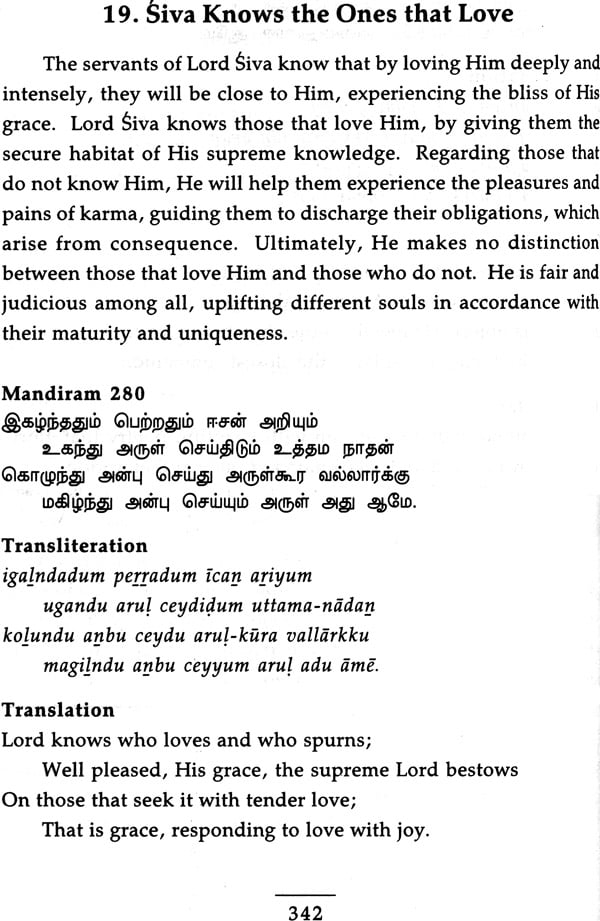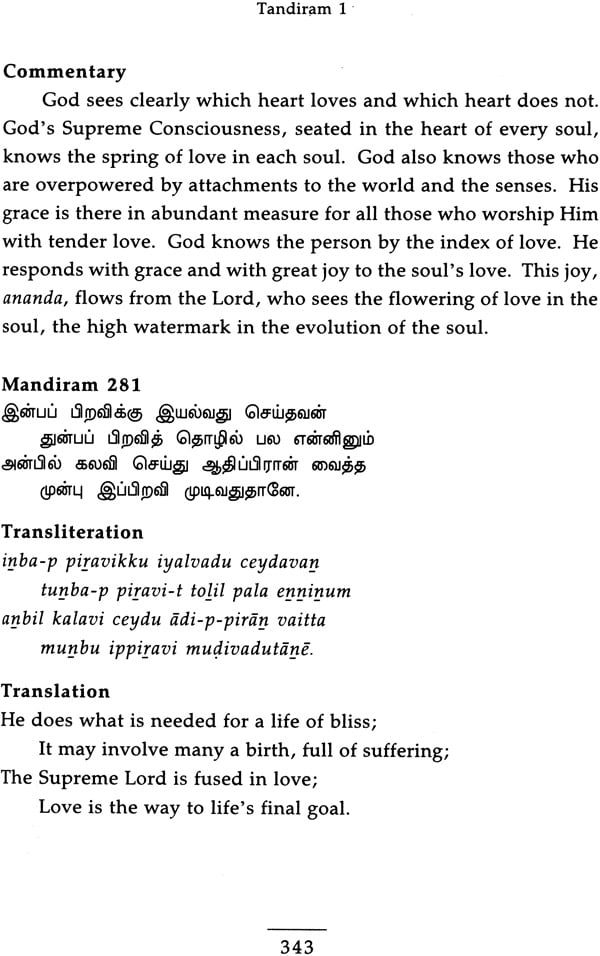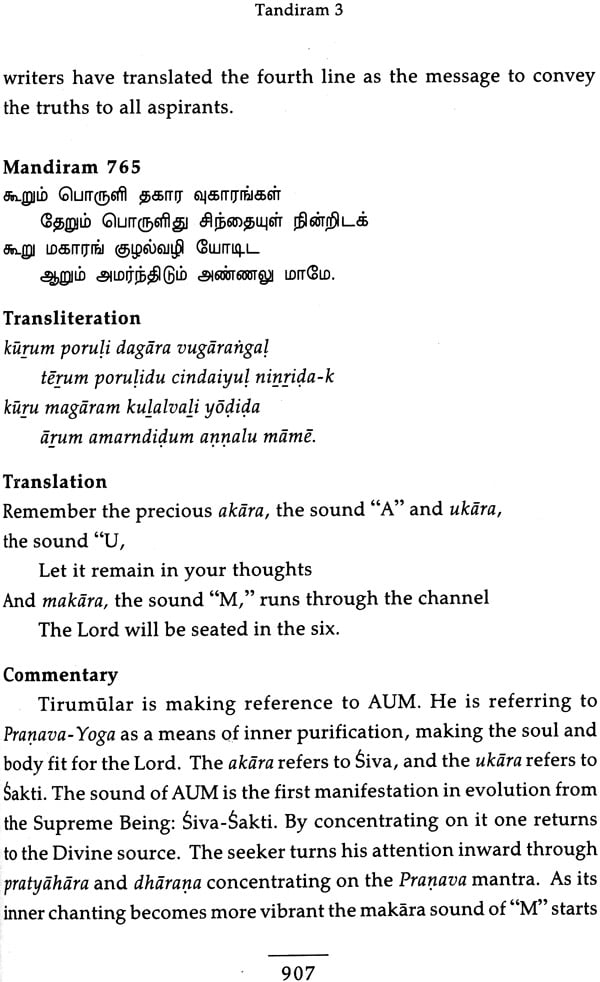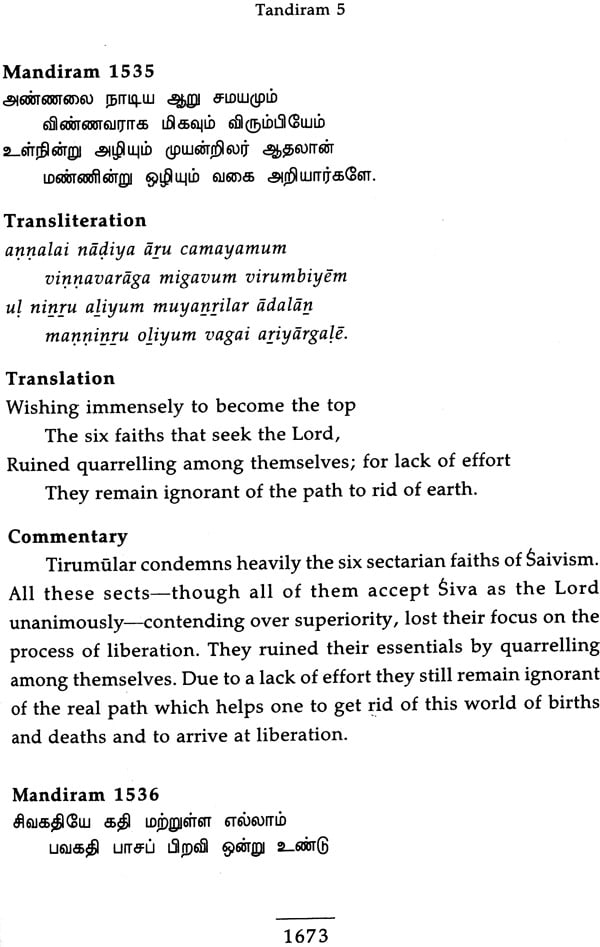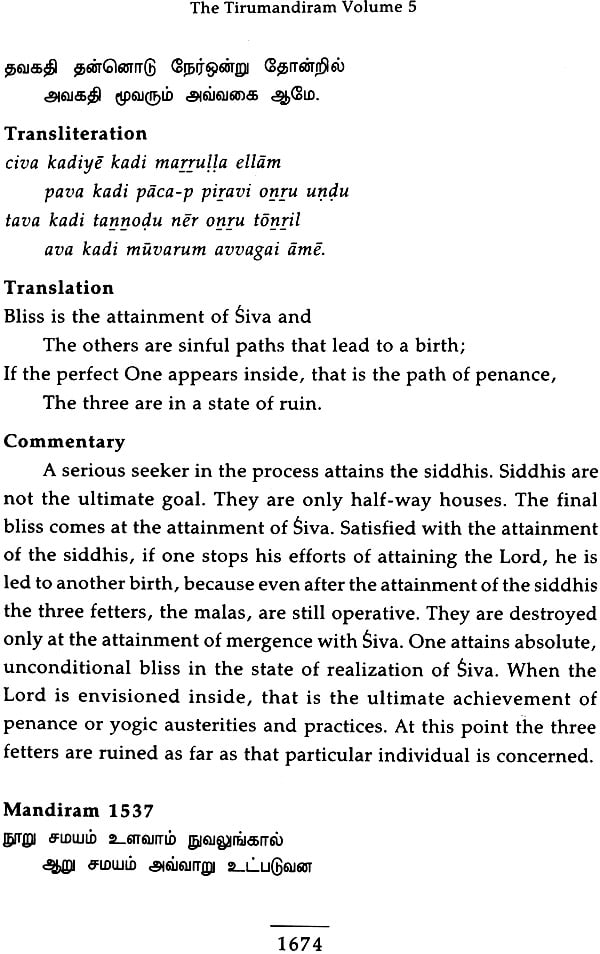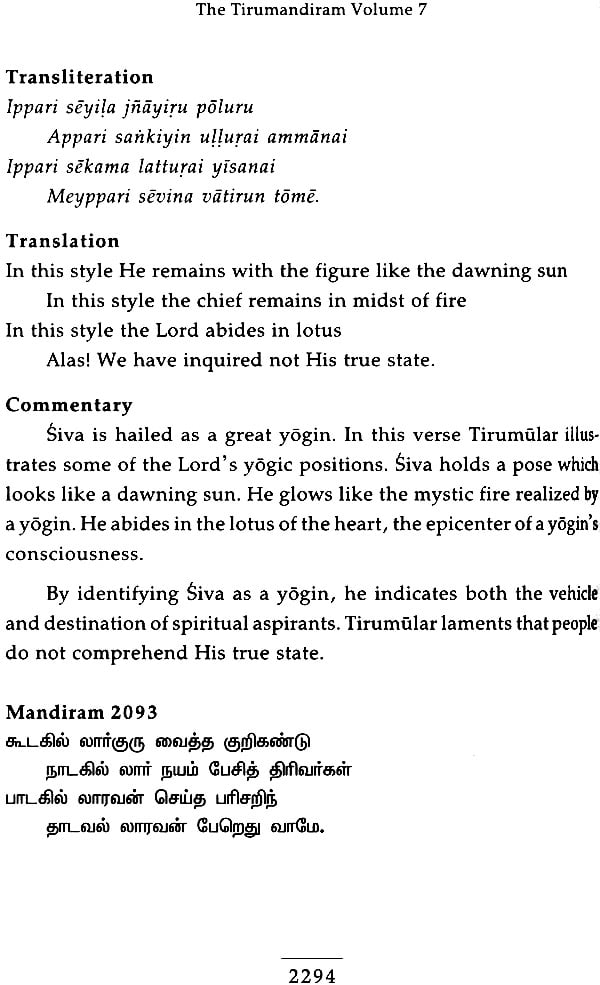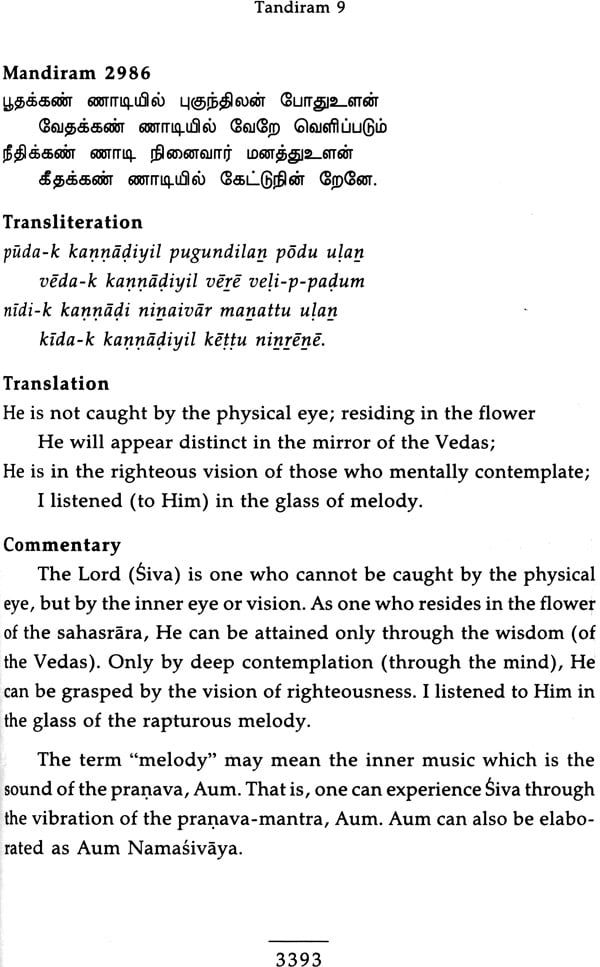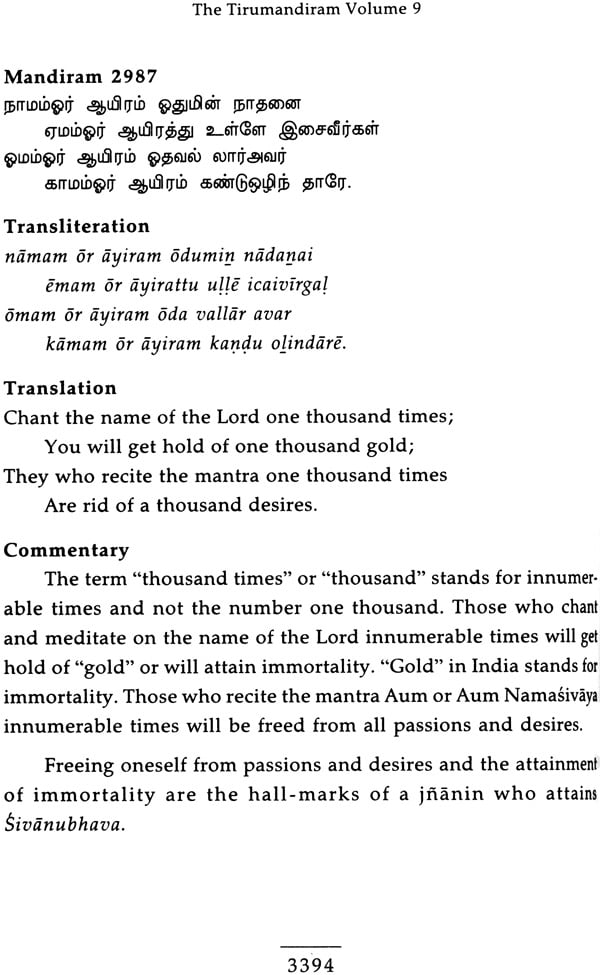
The Tirumandiram (Set of 5 Volumes) - Text, Transliteration, Translation and Detailed Commentary
Book Specification
| Item Code: | NAK531 |
| Author: | T.N. Ganapathy |
| Publisher: | Babaji’s Kriya Yoga Trust |
| Language: | Tamil Text with Transliteration and English Translation |
| Edition: | 2010 |
| ISBN: | 9781895383614 |
| Pages: | 3832 |
| Cover: | Hardcover |
| Other Details | 8.5 inch x 5.5 inch |
| Weight | 4.90 kg |
Book Description
Volumes I and II
About the Book
The Tirumandiram, by Siddha Tirumular is a sacred encyclopedia of philosophical and spiritual wisdom rendered in verse form. It is one of India's greatest texts, a spiritual treasure-trove, a Sastra containing astonishing insight. It is a seminal work and is the first treatise in Tamil that deals with different aspects of Yoga, Tantra and Saiva Siddhantha.
"The poems of Tirumular abound in technical terms conveying mystical experience. The symbolic, twilight language of the Siddhas has the advantage of precision, concentration, secrecy, mystery and esoteric significance in that the symbols, at the hands of the Siddhas become a form of artistic expression of the inexpressible. In short, the twilight language of the Siddhas is, in essence, profoundly mystical in nature and contains a "numinous aura" and existential revelations for the man who deciphers their message. The essential difficulty is that to understand the twilight language requires a total hermeneutic of reading, an awareness, in fact, of the total religious and philosophical structures that infuse it. It also requires one to enter deep states of meditation wherein the verse serves as a key that reveals a higher meaning to the initiate." (T.N. Ganapathy)
It took five years and a team of scholars to translate each of the 3000 verses and to write extensive commentaries about them, in nine volumes. The tenth volume contains presentations from two philosophical schools of Saiva Siddhanta and a glossary, select bibliography and index.
Foreword
This monumental publication and all of the research conducted by the Yoga Siddha Research Center's team of scholars and yogins since the year 2000 has been sponsored by Babajis Kriya Yoga Order of Acharyas, a registered educational charity in Canada and the USA, with sister organizations registered in Bangalore India and Sri Lanka. In concert with Babaji' s Kriya Yoga and Publications, Inc. of Canada, the Order is pleased to make this new translation and commentary available to the English speaking world.
There is some history behind this publication. The Tirumandiram is one of the first texts to emerge in the West from the gold mine of ancient Tamil literature, which until recently has been bypassed by scholars outside of south India. While the Sanskrit literature has been mined and studied by Western scholars for more than 200 years, the ancient Tamil language literature has been largely ignored. However, the late Swami Subramaniam, founder of the Saiva Siddhantha Church in Hawaii, USA, commissioned the late Dr. B. Natarajan to translate the Tirumandiram in the late 1980 'so Unfortunately, only the first of the nine tantras was published by the Saiva Siddhantha Church, prior to the death of the translator, Dr. B. Natarajan, in 1982. While it contained no verse by verse commentary, it did include some notes. Having received from Dr. Natarajan in person a copy. of this first tantra in 1980, and dismayed by the fact that the rest had not been published, I, as the founder of Babaji's Kriya Yoga and Publication, repeatedly urged Dr. Natarajan's heirs, from 1986 onwards, to allow me to publish the entire manuscript. Unknown to me, Dr. N. Mahalingam, the noted industrialist, philanthropist and scholar of Sangam literature, finally persuaded the heirs to do the same, and financed the publication of Dr. Natarajan's manuscript in a single volume published by the Ramakrishna Mission in Chennai, India in 1992. Seeing that this edition lacked the presentation which would make it appealing and useful to the vast majority of Western readers, Babaji's Kriya Yoga and Publications, Inc. received permission to publish it from the Ramakrishna Mission in September 2002. The new edition which we published in 1993 was a three volume international edition entitled the Thirumandiram: A Classic of Yoga and Tantra. This edition contained special introductory chapters, glossary and index which made it much more accessible to the readers in the West in particular. Since then, this publication has gone through five printings, and as a result, the Tirumandiram has become known to lovers of Yoga all over the world.
However, the need for a more accurate translation became apparent as Tamil speaking specialists pointed out that Dr. B. Natarajan had too often sacrificed precision for poetic grace. Furthermore, he neglected to translate many of the technical terms, and consequently, the average reader, with little or no background in the philosophical and rich cultural, esoteric and religious tapestry of the Tirumandiram, was often unable to grasp the significance of many of the verses. Finally, it became apparent that the non-specialist would need a running commentary along with translation, in order to easily understand the meaning and significance of most of the verses.
This present work fulfills this need and several others, which the previous translation did not. It has the advantage of being based on the Tiruppanandal Kaci-t-tirumadam edition. We have followed the numbering of verses of this edition only. It also has the advant- age of making use of the annotated and critical edition of the Tirumandiram written by Dr. S. Annamalai in 1999 for many critical points. To produce that critical edition, Dr. Annamalai examined thirteen different manuscripts of the Tirumandiram in their original Tamil language. From this examination, he was able to identify interpolations and other errors in several of the manuscripts.
This present edition also benefits from the experience and knowledge gained by the Yoga Siddha Research project's team of scholars, lead by Dr. T.N. Ganapathy. Since 2000, they have produced six volumes of translation and commentary on the works of the eighteen Yoga Siddhas. Tirumular, the author of the Tirumandiram, is one of these eighteen Siddhas, or supreme masters of Yoga, and like them, uses their twilight language, or sandhya bhasa, extensively to deliberately obscure the meaning of his verses, as well as many other of their literary forms and references. These scholars' unique experience and knowledge has. enabled them to produce what has never been done before: a precise English translation with verse by verse commentary of the entire Tirumandiram in nine volumes, plus a tenth volume, which serves as an index.
As a final step in preparing for the present publication, two years ago, we published The Yoga of Tirumular: Essays on the Tirumandiram, by Dr. T.N. Ganapathy and Dr. KR Arumugam. It develops many important themes of the Tirumandiram and serves as both an excellent introduction and companion resource for both the specialist and the non-specialist reader.
This edition of the Tirumandiram, because of its size, in well over 3,000 pages, has been a great challenge to publish. It was clear that with the exception of a few research libraries, very few individuals would want such a mammoth work on their book shelves, even if they could afford its high cost. Modern technology, in the form of digital storage on a DVD has provided a solution that is both convenient and affordable for the vast majority of potential readers. Also, it enables us to honor our commitment to "Green Yoga." In early 2 0 0 8, as we neared completion of this work, we therefore made a strategic decision to print only a limited number of copies in a paper edition, which will be made available to research libraries, and to make this new publication accessible to everyone who wants it, reproduced and stored in a digital form, on DVDs.
We are grateful, however, to Dr. N. Mahalingam who at the end of July 2009 offered to pay for the cost of printing 2,000 copies of the ten volumes in a hard bound set, and to distribute many of these to various institutions on a charitable basis. We concluded an agreement to co-publish the same, while at the same time going ahead with our plans for printing a single volume English translation of the 3,047 verses with a DVD containing all ten volumes inserted into its rear jacket cover.
It has also been a challenge to produce a translation that would not take sides in the important philosophical debate between Saiva Siddhantins or realistic pluralists, and those who see the Tirumandiram as an expression of the highest mystical states of consciousness accessible to the Yogin, or monistic theism. The views of the two sides are reproduced in the special introductory chapter. The translation and commentary itself has been kept neutral, with an aim of making the original terminology as clear and accessible as possible.
As the world wide interest in authentic Yoga grows, the importance and reputation of the Tirumandiram is bound to excel. May all lovers of truth and the Sanatana Dharma, in particular, find their path illuminated by the poetry and wisdom of Tirumular.
Preface
The main aim and purpose of publishing the content of the Tirumandiram, in nine volumes with the Tamil verses, their transliteration, their translation and commentary in English along with a separate volume (vo1.10) for glossary and index, is to allow the majority of Anglophones in our country and in other countries the opportunity to study this Tamil classic in depth. The Tamil Saiva and Siddha traditions have been largely ignored by both Indian and foreign scholars and deserve recognition for their great contributions to the understanding of the science of Yoga, spirituality and immortality. Although previously translated into English by B. Natarajan, and published by Ramakrishna Mission, Chennai, India and later by Sri. M. Govindan, the Tirumandiram has not previously had either verse transliteration or systematic commentary. One could only find a few sporadic translations and commentaries on verses of the Tirumandiram by J. M. Nallasami Pillai in the Siddhanta Dipikajournals published between 1897 and 1914, (now brought out in fourteen volumes by the Asian Educational Services, New Delhi). The foremost difficulty in carrying out this great enterprise was in finding competent translators among the Tamil-speaking scholars on this great subject. The aim of bringing out this series of nine volumes was so demanding that it made me stagger at times-myself being seventy-eight years young -and also made me wonder whether I was attempting the impossible. a
My concern about the impossibility of bringing out this series with commentary, moreover, grew intense due to two factors. First, certain Saivites object against writing a commentary, especially in English, on the sacred text of the Tirumandiram, the only tiru-murai (sacred Tamil Saiva scripture) that is both a cattiram (stotra, or philosophical treatise) and a tottiram (stotra, or devotional literary product) in the Tamil Saiva tradition. This traditionalist view gains its support in one of the verses by Tirumular himself.
Oh! Fools are they who try to describe the indescribable How can one explain the One that is boundless?"
One can counter this objection against rendering a translation and commentary by saying that one need not commend this spirit, however well intended it might be. Furthermore, there is also a favourable statement in the Tirumandiram itself.
The Lord with the matted locks stood blemishless to those whose mind is like a waveless sea.
How can the boundless One be bound in translations and commentaries? Tirumular provides the answer: Only those with a clear mind, that is, with a waveless mind, like the calm deep sea, can comprehend it. Though the translators and commentators claim no such mind, they seek and obtain protection in the words of Tirumular.
The second factor concerns a basic requirement of writing a commentary as found in Nannul, which I casually stumbled on. The Nannul, a Tamil work on grammar composed by the Jain ascetic Pavanandi of Kancheepuram, several centuries back, states that the work of a bhasya or commentary depends on fourteen characteristics, viz., pure text, purport, construction, word- meaning, paraphrasing, citing parallel passages, questioning, answering queries, adding fresh explanatory matter, free exposition, the relevancy of the sutras (aphorisms), comprising chapters or sections, giving the meaning boldly in doubtful cases, the result of this and quoting authority."
This second factor is being addressed by stating that this work (the present nine volumes) is not a bhasya in the strict sense of the term featuring the fourteen traditional characteristics, but only a general commentary in the ordinary sense of the term, viz., consisting of explanatory notes. The commentaries provided in these volumes are linguistic expressions of the mystical experiences of Tirumular, as expressed in the Tirumandiram. They claim only to provide the clues and guidelines for understanding the richness of the spiritual mystical experiences of the saint. It is said that those who read and interpret the scriptures and get "knowledge" through them are like bees hovering round the ripe jack-fruit. The bees may hum at the fragrance of the jack-fruit, but can never break into the kernel and have the taste of it. So it may be the case with the scholars who have commented on the Tirumandiram. The commentaries are meant to be guides, pointing to the goal, to the essence, but themselves are unrealized, mere descriptions of truth. In bringing out the the entire Tamil text in translation, saint Cekkilars words come before me. Cekkilar says:
Contents
| | Volume I | |
| | Publisher's Foreword | XV |
| | General Preface | XX |
| | Contributors | LXXX |
| | Guide to Pronunciation in Tamil | LXXXIX |
| | Introduction to Tandiram One | 1 |
| | Invocation of Lord Vinayaka | 11 |
| | Prologue (9 Sections) | 15 |
| 1. | In Praise of God | 17 |
| 2. | The Greatness of the Vedas | 72 |
| 3. | The Greatness of the Agamas | 80 |
| 4. | The Guru Tradition | 94 |
| 5. | The History of Tirumular | 101 |
| 6. | Humility in Assembly | 127 |
| 7. | Number and Import of the Tirumandiram Hymns | 131 |
| 8. | Spiritual Lineage | 133 |
| 9. | The Trinity and the Relationship | 136 |
| | Tandiram One (24 Sections) | |
| 1. | Instructions on the Essence | 147 |
| 2. | Transitoriness of the Body | 189 |
| 3. | Transitoriness of Wealth | 214 |
| 4. | Impermanence of Youth | 223 |
| 5. | Impermanence of Live | 233 |
| 6. | Non-killing | 243 |
| 7. | Meat-Eating, Forbidden | 246 |
| 8. | On the Evil of Adulterous Life | 248 |
| 9. | The Dishonourable Public Women | 252 |
| 10. | Poverty | 257 |
| 1l. | Efficacy of the Propitiation of Fire | 263 |
| 12. | Way of the Brahmins | 276 |
| 13. | A Code for Governance | 295 |
| 14. | In Praise of Rain | 307 |
| 15. | In Praise of Giving | 310 |
| 16. | In Praise of the Righteous | 312 |
| 17. | Path of the Unrighteous | 321 |
| 18. | By Love Possessed | 331 |
| 19. | Siva Knows the Ones that Love | 342 |
| 20. | Learning | 352 |
| 2l. | Fulfilling Inquiry | 363 |
| 22. | State of Being Unlearned | 374 |
| 23. | In the Midst of Grace | 385 |
| 24. | Abstention From Drink | 391-406 |
| | Volume II | |
| | Introduction | 411 |
| | Tandiram Two (25 Sections) | |
| 1. | Agattiyam | 415 |
| 2. | Eight Heroic Deeds of the Lord | 419 |
| 3. | Linga - Purana | 431 |
| 4. | Daksa ' s Sacrifice | 438 |
| 5. | The Deluge | 449 |
| 6. | Gift of a Discus | 455 |
| 7. | Skeleton and Skull | 460 |
| 8. | Search for the Crown and the Feet | 462 |
| 9. | Creation | 474 |
| 10. | Sustenance | 505 |
| 11. | Dissolution | 514 |
| 12. | Obscuration | 525 |
| 13. | Bestowing Grace | 535 |
| 14. | Creation (Microcosmic) | 545 |
| 15. | Three Categories of Souls | 586 |
| 16. | The Worthy Ones | 599 |
| 17. | The Unworthy Ones | 604 |
| 18. | Holy Waters | 608 |
| 19. | Desecration of the Holy Temple | 615 |
| 20. | Manifestation of Downward Face | 621 |
| 21. | Reproach of Siva | 628 |
| 22. | Reproach of Guru | 632 |
| 23. | Reproach of the Devotees of Lord Siva | 639 |
| 24. | Forbearance | 641 |
| 25. | Seeking the Holy Company | 645-650 |
Volumes III and IV
Contents
| | Volume III | |
| | Introduction | 659 |
| | Tandiram Three (21 Sections) | |
| 1. | Astanga Yoga (Eight-limbed yoga) | 661 |
| 2. | Yama (Abstentions) | 666 |
| 3. | Niyama (Observances) | 669 |
| 4. | Asanas (Postures) | 672 |
| 5. | Pranayama (Regulated Breath) | 678 |
| 6. | Pratyahara (Withdrawal of the Senses) | 695 |
| 7. | Dharana (Concentration) | 707 |
| 8. | Dhyana (Meditation) | 718 |
| 9. | Samadhi (Intense Contemplation) | 740 |
| 10. | Benefits of the Eight-Limbed Yoga | 756 |
| 11. | Eight Great Siddhis | 765 |
| 12. | State of Kalas | 840 |
| 13. | The Art of Keeping the Body Intact | 855 |
| 14. | The Wheel of Time | 877 |
| 15. | Measurement of the Life Span | 912 |
| 16. | Daily Pranic Rhythms | 937 |
| 17. | Hostile Days | 945 |
| 18. | Kechari –Yoga | 948 |
| 19. | Pariyanga – Yoga | 980 |
| 20. | Amuri Dharanai | 1004 |
| 21. | Candra-Yoga | 1012-1050 |
| | Volume IV | |
| | Introduction | 1055 |
| | Tandiram Four (13 Sections) | |
| 1. | The Silently Articulated | 1057 |
| 2. | The Cakra of Tiruvambalam | 1087 |
| 3. | Archana | 1173 |
| 4. | The Nine Sacrificial pits | 1184 |
| 5. | Various Forms of Sakthi - The Tirupurai cakra | 1213 |
| 6. | The Bairavi Mandiram | 1239 |
| 7. | Absolute sakti | 1281 |
| 8. | The Support and the Supported | 1305 |
| 9. | Yeroli Cakra | 1384 |
| 10. | The Cakra of Bhairava | 1412 |
| 11. | The Cakra of Sarnbhavi Mandala | 1418 |
| 12. | The Cakra of Bhuvanapati | 1427 |
| 13. | Navakkari Cakra | 1437-1512 |
Volumes V and VI
Contents
| | Volume V | |
| | Introduction | 1521 |
| | Tandiram Five (20 Sections) | |
| 1. | Pure Saivism | 1523 |
| 2. | Impure Saivism | 1531 |
| 3. | The Saivism that Helps to Attain Liberation | 1538 |
| 4. | Extreme Pure Saivism | 1554 |
| 5. | The Path of Service | 1561 |
| 6. | Ritualistic Worship | 1574 |
| 7. | Yoga | 1583 |
| 8. | Wisdom or Self-Realization | 1594 |
| 9. | The Path of Wisdom or Self-Realization | 1606 |
| 10. | The Path of Friend | 1618 |
| 11. | The Path of Son | 1626 |
| 12. | The Path of Servant | 1634 |
| 13. | Reaching the World of the Lord | 1640 |
| 14. | Proximity to the Lord | 1643 |
| 15. | Attaining the Form of the Lord | 1644 |
| 16. | Mergence with the Lord | 1646 |
| 17. | The Descent of Grace | 1649 |
| 18. | Condemning the External Faiths | 1667 |
| 19. | Misconduct | 1688 |
| 20. | Internal Faith | 1695 -1710 |
| | Volume VI | |
| | Introduction | |
| | Tandiram Six (14 Sections) | |
| 1. | The Vision of Siva as Guru | 1719 |
| 2. | The Merit or Grace of Guru's Feet | 1736 |
| 3. | The Subject, The Object and Knowledge | 1751 |
| 4. | Renunciation | 1761 |
| 5. | Penance | 1772 |
| 6. | Abuse of Tapas | 1780 |
| 7. | Attainment of Jnana is due to Divine Grace | 1793 |
| 8. | Disguised Vanity or Hypocrisy (Sanctimony) | 1802 |
| 9. | The Robes of Penance | 1808 |
| 10. | The Sacred Ashes | 1812 |
| 11. | The Robes of Jnana | 1815 |
| 12. | The Robes of Siva | 1823 |
| 13. | One who is Immature or Unfit | 1828 |
| 14. | One who is Mature or Fit | 1839 - 1851 |
Volumes VII and VIII
Contents
| Volume VII | | |
| Introduction | 1861 | |
| Tandiram Seven (38 Sections) | | |
| 1. | The Six Adharas | 1866 |
| 2. | The Cosmos as the Symbol of God | 1878 |
| 3. | The Body as the Linga | 1895 |
| 4. | Sadasiva Lingam | 1901 |
| 5. | The Soul as Linga | 1926 |
| 6. | The Linga of Gnosis | 1938 |
| 7. | Sivalingam | 1950 |
| 8. | The Sacred Tradition | 1956 |
| 9. | Bestowal of Grace | 1972 |
| 10. | The Glow of Grace | 1995 |
| 11. | Worship of Siva | 2006 |
| 12. | Worship of the Preceptor | 2033 |
| 13. | Worship of the Spiritual Servants | 2045 |
| 14. | The Greatness of the Spiritual Servants | 2057 |
| 15. | The Code of Feeding the Servants | 2073 |
| 16. | Code of Receiving Alms | 2076 |
| 17. | Variations in Mudra Gesture or Hand Pose | 2083 |
| 18. | Accomplished Samadhi in the Cave of the Heart | 2094 |
| 19. | Rituals of Samadhi | 2102 |
| 20. | The Origin of the Bindu | 2114 |
| 2l. | The conquest of Bindu and the device of | |
| | controlling the Life Breath at the time of Enjoyment | 2128 |
| 22. | The States of the Sun Macrocosmic | |
| | Sun - The Sun of the Universe | 2168 |
| 23. | The Sun of the World or The Microcosmic | |
| | Sun - the Sun of the Body | 2179 |
| 24. | The State of the Sun in the Mind | 2182 |
| 25. | The Sun of Gnosis | 2187 |
| 26. | The Sun of Siva | 2195 |
| 27. | The Character of the Soul | 2199 |
| 28. | The Individual Soul | 2202 |
| 29. | The Cultivated Soul | 2206 |
| 30. | The Soul that is Bound | 2211 |
| 3l. | The Enlightened One | 2214 |
| 32. | The Effort required to control the Five Senses | 2221 |
| 33. | The Method of Controlling the Five Sense Organs | 2230 |
| 34. | The Path of the Unholy Guru | 2244 |
| 35. | The Noble Guru | 2250 |
| 36. | The Unethical Conduct | 2269 |
| 37. | Compassion for the Soul's State of Misery | 2286 |
| 38. | The Salutary Guidance | 2304 |
| | Volume VIII | |
| | Introduction | 2327 |
| | Tandiram Eight (43 Sections) | |
| 1. | Five-fold Differences of the Body | 2351 |
| 2. | Relinquishment of the Body | 2376 |
| 3. | Different States of Experience of | |
| | the soul-Lower State of Experience | 2380 |
| 4. | Middle Waking State | 2415 |
| 5. | The Paths for Liberation | 2437 |
| 6. | Pure Waking State and Other States | 2444 |
| 7. | Triple States of the Soul | 2493 |
| 8. | The Supreme State | 2543 |
| 9. | Devoid of Triple Gunas | 2573 |
| 10. | Different World Systems | 2575 |
| 11. | Even the Eleventh Kala is to be seen as an | |
| | Avastha "state" | 2578 |
| 12. | Mingling and Departing | 2582 |
| 13. | The State Free From Impurity | 2585 |
| 14. | The Dawn of Spiritual Knowledge | 2640 |
| 15. | The Six Ends | 2656 |
| 16. | The Non-Difference of Pati, Pasu and Pasa | 2698 |
| 17. | Exposition of Realizing the Feet and the Head | 2720 |
| 18. | The Three Defects | 2732 |
| 19. | The Three Words | 2735 |
| 20. | The Three-fold Paras | 2743 |
| 21. | The Nature of the Supreme Lord Siva | 2750 |
| 22. | Three-fold Turiyas | 2764 |
| 23. | Three-fold Muktis | 2772 |
| 24. | Three-fold Svarupas (Real Nature) | 2777 |
| 25. | Triple Instruments | 2785 |
| 26. | Three Voids and Tat Tvam Asi | 2789 |
| 27. | Three Illusions | 2796 |
| 28. | The Adjuncts of Jiva and Para | 2804 |
| 29. | The State of Tranquility | 2809 |
| 30. | Avoidance of Out-Speaking | 2816 |
| 31. | The State of the Soul within Triple Gunas | |
| | in the Sphere of the Eight-Petalled Lotus | 2831 |
| 32. | Ninefold States and Ninefold Presiding Deities | 2842 |
| 33. | The Pure and the Impure | 2853 |
| 34. | Disdain of Liberation | 2865 |
| 35. | Three Types of Implied Meaning | 2874 |
| 36. | The Great Statement - Tat Tvam Asi | 2883 |
| 37. | The Morsel of Cosmos | 2902 |
| 38. | Truthfulness | 2911 |
| 39. | The Performance of a Jnani | 2926 |
| 40. | Curbing the Desire | 2930 |
| 41. | The Significance of Devotion | 2940 |
| 42. | The Attainment of Eternal Bliss | 2950 |
| 43. | Inquiry | 2953 - 2966 |
Volumes IX and X
Contents
| | Volume XI | | |
| | Introduction | 2977 | |
| | Tandiram Nine (23 Sections) | | |
| 1. | The Vision of the Monastery of the Guru | 2981 | |
| 2. | The Vision of the Jnana Guru who is the Embodiment of Wisdom | 2994 | |
| 3. | Pranava-Samadhi | 3018 | |
| 4. | Light | 3025 | |
| 5. | The Pancaksara Mantra-Gross | 3045 | |
| 6. | The Pancaksara Mantra-Subtle | 3058 | |
| 7. | The Pancaksara Mantra-Super Subtle | 3068 | |
| 8. | The Vision of the Sacred Dance of Siva | 3073 | |
| 9. | The Attainment of Space Within | 3156 | |
| 10. | The Dawn of Wisdom | 3166 | |
| 11. | Sat-Cit-Ananda | 3176 | |
| 12. | The Dawn of the Real Nature of Sivam | 3190 | |
| 13. | Karma (ul) | 3202 | |
| 14. | The Vision of Siva | 3208 | |
| 15. | The Vision of the Essential Nature of Siva | 3211 | |
| 16. | Gradations of Liberation, Release from Karma | 3220 | |
| 17. | The Conversation About the Void | 3222 | |
| 18. | The Silent State of Samadhi | 3343 | |
| 19. | The Greatness of the Unlimited | 3361 | |
| 20. | The Greatness of the Realized Ones | 3364 | |
| 21. | Panegyric (Laudation/Tribute) | 3389 | |
| 22. | The All-Pervasive One | 3431 | |
| 23. | Benediction | 3450 | |
| | Volume X | | |
| 1. | Appendix One | | |
| | Debate within Saiva Siddhanta Regarding The Tirumandiram | | |
| 1. | Monism and Pluralism in Saiva Siddhanta | 3457 | |
| 2. | There Can Be Only one Final Conclusion in Saiva Siddhanta | 3514 | |
| 2. | Glossary - T.N. Ganapathy | 3637 | |
| 3. | Select Bibliography - T.N. Ganapathy | 3717 | |
| 4. | Index - Ramesh Babu | 3725 | |
| 5. | The thirty-six principles of existence to Saiva Tandiram | 3832 | |
| | Courtesy: George Feuerstein | | |
| | (Appendix Two) | | |
